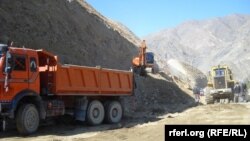When the renowned U.S. construction company Morrison-Knudsen started operating in the Helmand Valley in 1946, its proprietors were lured by a booming, post-World War II Afghanistan open to new technologies and economic development. At its height, the factory they built in Chah-e Anjir employed more than 15,000 people.
Envisioning an agricultural golden age, Morrison-Knudsen Afghanistan constructed dams, roads, and buildings throughout Helmand Province. But after three decades of civil war, the factory at Chah-e Anjir has been reduced to a shell. Looted by warlords and destroyed by military operations, scraps of its machinery now appear at markets in neighboring countries.
Located in Helmand's Nad Ali district, the mostly obsolete industrial complex covers 187 acres of green pastures with parks, residential housing, technical workshops, education centers, and exercise areas.
"The Chah-e-Anjir construction company was the biggest factory in Afghanistan," says current factory supervisor Haji Malim Shah Wali. "Aside from the 15,000 factory employees, its staff included 2,600 official engineers who were dispatched to different parts of Afghanistan to supervise construction projects."
Following the collapse of Mohammad Najibullah's pro-Soviet government in 1992, "some of the powerful and militia run individuals disbanded the machinery and equipment of the factory," said Shah Wali. "For almost a year, every day without delay, the disbanded machinery was loaded on to trucks and sent to Pakistan as scraps. We know some of the machinery was put back together in Pakistan and used."
In 2009, British troops based in the province dismantled the remaining equipment and machinery at Chah-e-Anjir. "Workshops were burned down to make room for residential units for the British soldiers stationed in Helmand," Shah Wali said.
The company still employs 59 engineers in Helmand Province, two in Kandahar Province, five in Nimruz Province, 12 in Farah, and 15 in Herat Province who still report to the factory administration. The factory still contains machine tools and has recently produced machine parts.
Originally, the Chah-e-Anjir factory housed thousands of machines and equipment used for constructing roads, canals, government buildings, and bridges. The current inventory includes 30 pieces of machinery and 18,000 spare parts, but much of the equipment is disused and in need of maintenance.
"With what is left, all we can do is clean [irrigation] canals," Shah Wali said.
Haji Mohammad Sadiq, a resident of Chah-e-Anjir, says that if the factory was still active, the quality of construction and development in the province would improve. The factory took seven years to be completed and attracted engineers from all over Afghanistan, Sadiq recalls. The Americans who built this factory had their homes inside the premises of the factory, he adds. "It was a peaceful time then. The Americans coming to Helmand loved this place. They all came with their families and lived here."
The factory administration has several times pleaded with the government and international community to help reconstruct the factory. "President Ashraf Ghani has said he will establish an office to oversee the reconstruction of enterprises such as Chah-e-Anjir," Shah Wali said. "We have pinned our hopes on that."






